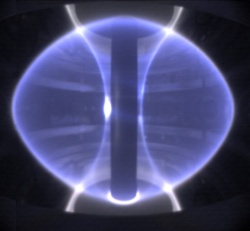Mega Ampere Spherical Tokamak
51°39′33″N 1°13′50″W / 51.65917°N 1.23056°W
| Mega Ampere Spherical Tokamak | |
|---|---|
 Plasma in the MAST reactor | |
| Device type | Spherical tokamak |
| Location | Culham, Oxfordshire, UK |
| Affiliation | Culham Centre for Fusion Energy |
| Technical specifications | |
| Major radius | ~ 0.9 m (2 ft 11 in) |
| Minor radius | ~ 0.6 m (2 ft 0 in) |
| Plasma volume | 8 m3 |
| Magnetic field | 0.55 T (5,500 G) |
| Heating power | 5 MW |
| Plasma current | 1.3 MA |
| History | |
| Date(s) of construction | 1997 |
| Year(s) of operation | 1999–2013 |
| Preceded by | Small Tight Aspect Ratio Tokamak (START) |
| Succeeded by | MAST Upgrade |
Mega Ampere Spherical Tokamak (MAST) was a nuclear fusion experiment, testing a spherical tokamak nuclear fusion reactor, and commissioned by EURATOM/UKAEA. The original MAST experiment took place at the Culham Centre for Fusion Energy, Oxfordshire, England from December 1999 to September 2013. A successor experiment called MAST Upgrade began operation in 2020.[1]
Design
A spherical tokamak is shaped more like a cored apple than the conventional, doughnut-shaped toroidal design used by experiments such as ITER. Spherical tokamaks are more efficient in their use of the magnetic field.
MAST included a neutral beam injector for plasma heating. It used a merging compression technique for plasma formation instead of the conventional direct induction. Merging compression saves central solenoid flux, which can then be used to increase the plasma current and/or maintain the required current flat-top.
MAST's plasma volume was about 8 cubic meters. It confined plasmas with densities on the order of 1020/m3.
MAST's plasma had an almost circular outer profile. The extensions off the top and bottom are plasma flowing to the ring divertors, a key feature of modern tokamak designs.
Experiments
MAST confirmed the increased operating efficiency of spherical tokamaks, demonstrating a high beta (ratio of plasma pressure to the pressure from the confining magnetic field). MAST performed experiments on controlling and mitigating instabilities at the edge of the plasma – so-called Edge Localised Modes or ELMs.
History
MAST
MAST was designed to confirm the results of the earlier Small Tight Aspect Ratio Tokamak (START) experiment (1990-1998) in a larger, more purpose-built experiment.
The MAST design phase occupied 1995-1997, with construction beginning in 1997, and the first plasma obtained in 1999.
The first results of the MAST demonstrate that H-mode is reached with more ease and less energy than expected with a considerable improvement in confinement, a fundamental point for any energy production scenario. Finally, different scenarios have been successfully tested to decrease the energy flow in the central solenoid vs plasma current, which represents another fundamental point for designing a demo spherical tokamak.[2]
Over its lifetime MAST produced 30,471 plasmas (in pulses up to 0.5 sec). In October 2013 the reactor was shut down for the upgrade to MAST Upgrade.[3]
MAST Upgrade
MAST Upgrade is the successor experiment to MAST, also at Culham Centre. The upgrade, which cost £45M, started in 2013 and was expected to significantly exceed MAST’s heating power, plasma current, magnetic field and pulse length.
MAST Upgrade began operation on 29 October 2020.[4]
One of MAST Upgrade's most notable features is the Super-X divertor. The divertor removes excess heat and impurities from the plasma. Conventional divertor designs, at powerplant scale, will experience high heat loads and will need to be regularly replaced. The Super-X divertor was expected to produce heat loads that are lower by around a factor of ten[5] and has been seen as initially successful.[6]
Spherical Tokamak for Energy Production
The design of the next generation Spherical Tokamak for Energy Production (STEP) began in 2019 with £220 million in government funding. The plan is to begin operations in the 2040s.[7] The current plan does not include a tritium generation facility.[8]
See also
- National Spherical Torus Experiment, US version - 1st plasma 1999.
- List of fusion experiments
- ELM (Edge Localized Mode)
- Ball-pen probe
- Langmuir probe
- Resonant magnetic perturbations
References
- ^ "MAST Upgrade Research Plan, November 2019" (PDF). Culham Centre for Fusion Energy. Retrieved 2020-10-26.
- ^ Sykes, A.; Akers, R.J.; Appel, L.C.; Arends, E.R.; Carolan, P.G.; Conway, N.J.; Counsell, G.F.; Cunningham, G.; Dnestrovskij, A.; Dnestrovskij, Yu.N.; Field, A.R.; Fielding, S.J.; Gryaznevich, M.P.; Korsholm, S.; Laird, E. (October 2001). "First results from MAST". Nuclear Fusion. 41 (10): 1423–1433. Bibcode:2001NucFu..41.1423S. doi:10.1088/0029-5515/41/10/310. ISSN 0029-5515. S2CID 250816599.
- ^ "News: It's goodbye to MAST - and hello to MAST Upgrade". Ccfe.ac.uk. Archived from the original on 2017-06-16. Retrieved 2015-12-11.
- ^ Rincon, Paul (2020-10-29). "EUROATOM fusion experiment in UK used in hunt for clean energy". BBC News Online. Retrieved 2020-10-30.
- ^ "EUROATOM experiment could sweep aside fusion hurdle". BBC News Online. 2021-05-26. Retrieved 2021-05-26.
- ^ "Mast Upgrade: UK experiment could sweep aside fusion hurdle". BBC News. 2021-05-25. Retrieved 2021-05-26.
- ^ "STEP". Culham Centre for Fusion Energy. Retrieved 2020-11-27.
- ^ Clery, Daniel (2020-12-02). "U.K. seeks site for world's first fusion power station". Science. doi:10.1126/science.abf9768. ISSN 0036-8075. S2CID 230611562.
External links
- MAST Main Page
- Photos of MAST Archived 2012-03-16 at the Wayback Machine
- First results from MAST. 2001 Summary of first 6 months
- MAST Upgrade Research Plan, November 2019
